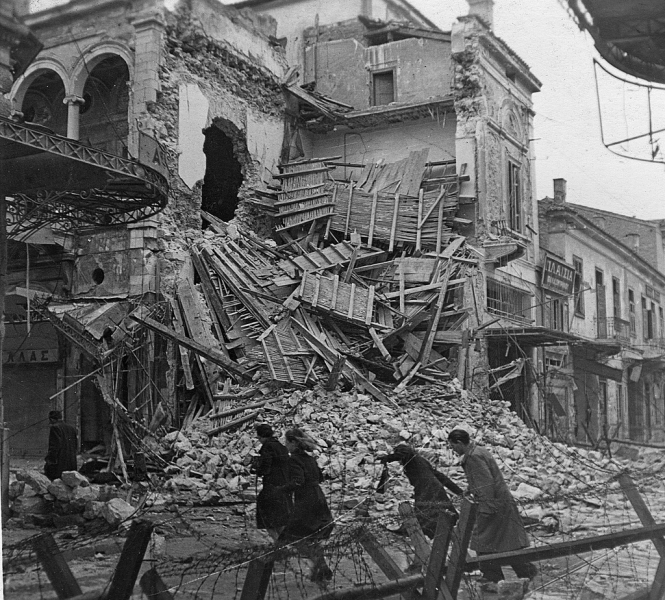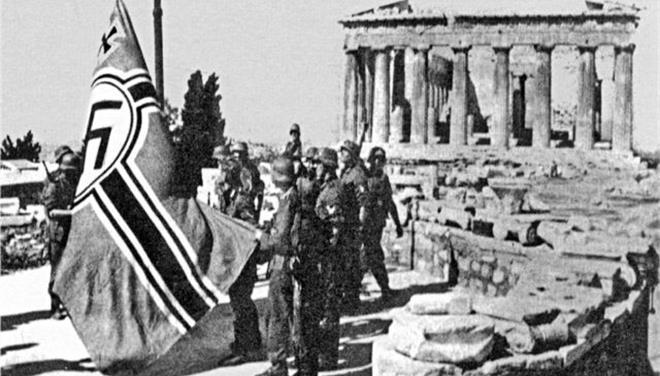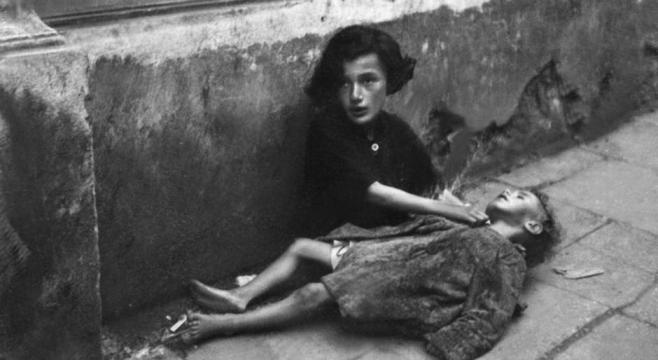Picture: www.tovima.gr
In his historical study, urbanist Konstantinos Doksiadis (1913-1975) estimated the damage in terms of GDP for Greece caused by Germany, Italy and Bulgaria during the occupation in World War II for a period of 33 years, or Greece’s budget for 130 years.
However, of the 17.8 billion pre-war dollars which Greece claims, it has received only crumbs because of the opinion of the allies. Doksiadis, as government coordinator for all co-responsible ministries, calculated what it cost Greece.
The online edition of To Vima reviewed the report of Doksiadis, which is kept in the National Library of Greece under the title "Victims of Greece: claims and reparations in the Second World War."

Extermination with weapons and stoppage of exports
According to the report, compared to 1938, the decreased land processing and the average agricultural yield (1941-1944) reached 40% for cereals; up to 36% for legumes, 89% for tobacco, and up to 75% for other types such as vines. Forestry also suffered major damage. According to the survey, 25% of forests were cut down and Attica lost 75% of its forests. Draft animals decreased by 60% compared to 1939, while sheep and goats and poultry - by 50% and sows by 80%.
The mining industry (iron, manganese, nickel, chromium) was destroyed, while exports decreased by 29% in 1940 alone. As regards the overall trade balance - overall imports decreased by 6%, 10% and 12%, respectively, over the period 1941 to 1942, and exports - by 8%, 6% and 3%, respectively. Imports of meat to feed the population dropped almost to zero, as well as imports of live animals.

Complete destruction of infrastructure
According to the report, 75% of the Piraeus-Plati railway line was destroyed, as well as 100% of the Thessaloniki-Florina and Thessaloniki-Idomeni railways, and 23% of the Thessaloniki-Alexandroupoli railway line. About 80% of railway stations were destroyed, as well as 40% of bridges. Damage was estimated at 8 billion pre-war drachmes or 72 million pre-war dollars.
The road network also suffered damage – damage there amounted to 53,400,000 pre-war dollars. Equipment (cars, rollers, other machines) from the public and private sectors also suffered damage amounting to 4.2 pre-war dollars. According to Doksiadis, 85% of the infrastructure had been destroyed.
The Corinth Canal was destroyed
Damage of ports was also enormous. Its value reached 4.7 million pre-war dollars for the port of Piraeus, 1,300,000 pre-war dollars for the port of Volos and 1.2 million pre-war dollars for the port of Thessaloniki. In the Corinth Canal, the Germans sank ships and detonated the bridge in order to make it unusable for as long a period as possible. Damage amounted to 860,000 dollars.
The technical marvel of the interwar period was destroyed
Germans and Bulgarians destroyed large hydraulic and irrigation systems in fields around Thessaloniki and Serres, the construction of which had led to a sharp increase in agricultural production before the war. The damage amounted to 13.2% in Thessaloniki and 38.6% in Serres and Drama, reaching 2 billion pre-war dollars.
74% of cargo ships and 94.5% of passenger ships were destroyed. Of the 583 merchant ships that Greece had in 1939, 434 were destroyed.
A quarter of the housing stock was destroyed

A total of 409,000 buildings were destroyed, as well as 23.6% of the pre-war housing stock, of which 111,000 were destroyed by arson and revenge. Germans destroyed 208,500 buildings. The total cost of the devastation amounted to 61 billion pre-war drachmes.
According to Doksiadis’s report:
- 3,700 settlements suffered from bombings, robberies and arsons
- 1.2 million inhabitants, 18% of the population, became homeless
- 88,000 farming families were living in ruins and 100,000 urban families - in appalling conditions.
- 15,000 shopkeepers and artisans lost their shops
- 80,000 families sold their homes and lost their property
- 5,000 schools were destroyed
- 1.5 million families lived in houses without windows, light or heating.
Robbery and destruction of monuments and museums

Many monasteries and 7 large Byzantine churches were destroyed completely (6 of them by the Germans), 12 others suffered serious damage. Venetian buildings were destroyed, as well as libraries and museums.
According to Doksiadis, Germans caused injury to 87 archaeological sites, Italians to 39, and Bulgarians to 3. Archaeological treasures were also stolen – Germans stole from 42 museums, Italians - from 33, and Bulgarians - from 9.
Mass death because of inflation
Monetary circulation in September 1944 reached 7.3 quadrillion drachmes. As a result, the feeding of an average family sharply deteriorated and reached levels of malnutrition. According to Doksiadis, the purpose of the conquerors was to acquire what they needed by paying with money that had no coverage and which cost them nothing.
300,000 people died of starvation

1 kg of bread cost 10 drachmes in 1941 and 153 drachmes over the next 3 years. Consequences included poor diet, and in the winter of 1941-1942 only 4% of people were eating enough. In mountainous areas, abandoned children were found who were unable to move and speak because of malnutrition. Mortality was 6-fold higher.
There were large migrations of people. Bulgarians took 40,000 citizens hostage, Italians -10,000, the Nazis - 70 000, of which 60,000 Jews.
How Greece's demands were welcomed
According to Doksiadis, damages were calculated not based on what was actually destroyed but on what could be proven. Victims of the population (death, disease, and reduced fertility) were not included. According to Doksiadis, system work proved that the damage amounted to 17.8 billion pre-war dollars or 1.994 trillion pre-war drachmes.
Three years’ GDP disappeared
In 1938, total government revenues amounted to almost 60 billion drachmes, and the budget - 15,000 drachmes. According to Doksiadis, Greece’s claims were for a GDP for 33 years or for the state budget for 130 years.
Distribution of reparations is as follows:
- 60.9% from Germany, i.e. 10.8 billion dollars or 1.2 trillion drachmes
- 33.6% from Italy, i.e. 6 billion dollars or 670 billion drachmes
- 5.5% from Bulgaria, i.e. almost 1 billion dollars or 198 billion drachmes
Reparations from Germany corresponded to 1/3 of its GDP; Italy’s – to a year’s GDP; Bulgaria’s to the GDP for 2 years. According to Doksiadis, in order for the Greeks to recover the damage, they have to work for 33 years, and those responsible - much less, in order to recover what they destroyed.
Greece is getting crumbs
The arguments of the allies in terms of reparations are different. According to them, Germany should recover, Italy is very poor, but Bulgaria has made sacrifices for the allies. Thus, the Greek claims were ignored, and Greece received only a small amount.
It receives only1% despite the destruction
According to Doksiadis Greece suffered more losses than any other country. However, Germany will pay only 1/300 of GDP, Italy - 1/100 of GDP and Bulgaria - 6% of GDP, while Greece, which caused no damage to anyone, will lose 33 times GDP.
Damage amounting to 2,220 dollars per person
According to Doksiadis, despite the fact that damage amounts to 2,250 dollars per person, reparations amount to 30 dollars per person, i.e. a liability of 2,200 dollars per person remains. According to him, some countries with less damage received higher benefits.